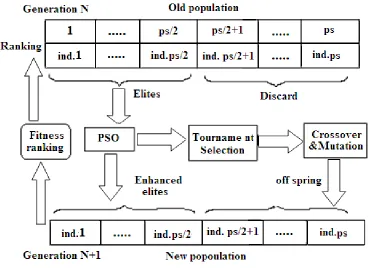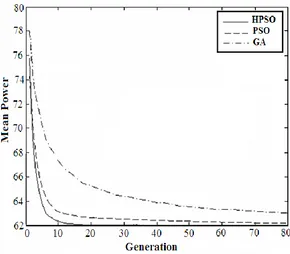2019 International Conference on Applied Mathematics, Modeling, Simulation and Optimization (AMMSO 2019) ISBN: 978-1-60595-631-2
Multicast Power Minimization Algorithm Based on PSO for
Multicast Algorithm
Xiao-ling WU
School of Information Technology and Engineering, Guangzhou College of Commerce, Guangzhou, China, 511363
Keywords: MPM, Minimization algorithm, PSO.
Abstract. MPM problem has been mathematically formulated to a constrained optimization problem by using Hybrid PSO. Considering that the centralized algorithm requiring a global knowledge of the networks is impractical in large wireless networks, the distributed version of the centralized algorithm is employed, which requires multihop neighborhood information under the assumption that limited frequency band is available. A variety of simulations have been conducted to examine the performance of the proposed approach and the results show that our algorithm consistently outperforms existing techniques.
Introduction
Wireless mesh networks (WMN) are multi-hop networks, composed of wireless links, that are typically composed of static wireless mesh routers and potentially mobile mesh clients. The major advantage of multicast routing lies in its capability of saving network resources since only one copy of message needs to be transmitted over a link shared by paths leading to different destinations. One of the major concerns in ad hoc wireless networks is reducing node energy consumption. Several algorithms for constructing minimum power broadcast trees have been presented in . Initial research on multicast routing mainly focused on the problem of finding a minimum Steiner tree. The broadcast incremental power (BIP) algorithm proposed in [108] exploits wireless multicast advantage, and provides better performance than the minimum spanning tree (MST) and shortest-path tree (SPT). Wieselthier et al. proposed the BIP algorithm, which is based on the greedy heuristic method and provides a very fast sub-optimal solution.
Related Work
Apart from minimum Steiner tree approaches, and a few local search approaches the MEM problem in the case of omnidirectional antennas has mostly been tackled with heuristics for the minimum energy broadcast (MEB) problem with a subsequent pruning procedure to eliminate unnecessary transmissions. Kang and Poorvendran considered maximizing network lifetime broadcast tree problem in both symmetric and asymmetric networks with the objective to keep the broadcast tree alive as long as possible until the power energy in a node expires. However focused only on a single broadcast flow and does not address the problem of how individual flows should be routed to maximize the total admissible volume of broadcast/multicast traffic in the presence of inter-flow and intra-flow interference.
The Proposed Method
Formulation Problem
attenuation due to the physical distance between transmitter and receiver in a wireless scenario. A graph representation for the multicast tree in an ad-hoc network is proposed in . Given a connected weighted undirected graph G = (V, E), V = {v1, v2, ... , vn} is the vertex set of G, and the E = {e1, e2, ... , em}is a finite set of edges represent the connections between these vertices of G. Let The same concept is applied to the MPM problem here in order to model the broadcast tree in the ad-hoc network. We represent an ad-hoc network by a node-weighted directed graph G = (N, E, p), where the vertices in N = {1, 2, … , N} represent the individual mobile node, E characterizes the set of transmission links in the network.
The subgraph of G can be expressed using a vector x = {x1, x2, ... , xm}where each element xi can
be defined as follows
otherwise xi , 0 subgraph in the selected is e edge if , 1
xi = {1, ifedgeeisselectedinthesubgraph
0, Otherwisse (1)
The element qu in q, which denotes the transmission power required of by node u for its transmission in the multicast tree is given by
otherwise 0 E v) edge(u, if ) , max(
uv uv u
P x q
qu= {max(x0uv, Puv)ifedge(u, v) ∈ Eotherwise (2)
HPSO for MPM Problem
PSO and GA has been successfully used to perform a wide range of optimization problems [116]. Each particle in the swarm represents a multicast tree. The population of permutation-based chromosomes is initialized by employing a hybrid of random and deterministic approaches, where P is known as the population size. In order to produce the deterministic solution, the MPM algorithm is run first and the corresponding node subsequently added to the broadcast tree is recorded into a node sequence, which serves as the deterministic population for the proposed HPSO approach.
Based on the node sequence, the construction of the broadcast tree can be carried out using HPSO algorithm as follows:
Input: source node s and chromosome cp [c1p,...,cNp];
Figure 1. HPSO.
1) Initialize PT=0, mark the source node s in the permutation cp to avoid the subsequent selections;
2) Obtain the first unmarked node z in permutation cp, construct a link between source nodes s and z, and assign the required power psz to the source node;
3) Check all the remaining unmarked nodes in the permutation to see if any other node is already covered by the above transmission between nodes s and z, mark those nodes to avoid the subsequent selections;
4) Go through the unmarked node z′ in permutation sequentially. Employ the rules of the MPM algorithm to add node z′ to the existing tree and assign a power ps′z′ to the corresponding source
node (assuming it is s′);
5) Check all the remaining unmarked nodes in the permutation to see if any other node is covered by the above transmission between nodes s′ and z′, mark those nodes to avoid subsequent selections;
6) If not end of permutation, go to 5;
7) Calculate PT by eq.(4), and form a Multicast tree T in which all constructed links correspond to the edges in T.
Simulation and Discussion
In our network model there are 20 nodes including one source node and four sink nodes. And the maximum generation is 80, the swarm scale is 40. This part we make a comparison of the simulation results among HPSO, GA.
Figure 2. Multicast tree power with swarm scale 80.
Summary
Multicast routing problem arises in many multimedia communication applications, computing the band-width-delay constrained least-cost multicast routing tree is a NP-complete problem. In this paper introduce multicast power minimization algorithm based on hybrid PSO for multicast algorithm. The experimental results show that this algorithm has performance. The simulation results show that the HPSO combines the advantage of fast convergence, the better global.
References
[1]Ian F. Akyildiz, Xudong Wang, and Weilin Wang. Wireless mesh networks: a survey. 2004 Elsevier B.V.
[2]M. Cagalj, J-P Hubaux, and C. Enz. Minimum-energy broadcast in all wireless networks: NP-completeness and distribution issues. Proc. of MobiCom’02, ACM, 2002.
[3]J. Wieselthier, G. Nguyen, and A. Ephremides. On the construction of energy-efficient broadcast and multicast trees in wireless networks. In Proceedings of the IEEE Infocom 2000 Conference, Tel-Aviv, Israel, March 26–30, pp. 585-594, 2000.
[4]R. Draves, J. Padhye, and B. Zill. Routing in multi-radio, multi-hop wireless mesh networks. In Mobicom, pages 114–128, 2004.
[5]Ashish Raniwala, Kartik Gopalan, and Tzi cker Chiueh. Centralized channel assignment and routing algorithms for multi-channel wireless mesh networks. Sigmobile Mob. Comput. Commun. Rev., 8(2):50–65, 2004.
[6]S. Pettie, and V. Ramachandran, “An optimal minimum spanning tree algorithm”, Journal of ACM, Vol. 49, no.1, pp. 16-34, Jan. 2002.
[8]R.J. Marks II, A.K. Das, M. El-Sharkawi, P. Arabshahi, and A. Gray. Minimum power broadcast trees for wireless networks: optimizing using the viability lemma. In Proceedings of the IEEE International Symphosium on Circuits & Systems, Scottsdale, AZ, May 26-29, 2002.
[9]A.K. Das, R.J. Marks, M. El-Sharkawi, P. Arabshahi, and A. Gray. r-shrink: A heuristic for improving minimum power broadcast trees in wireless networks. In Proceedings of the IEEE Globecom 2003 Conference, San Francisco, CA, December 1-5, 2003.

